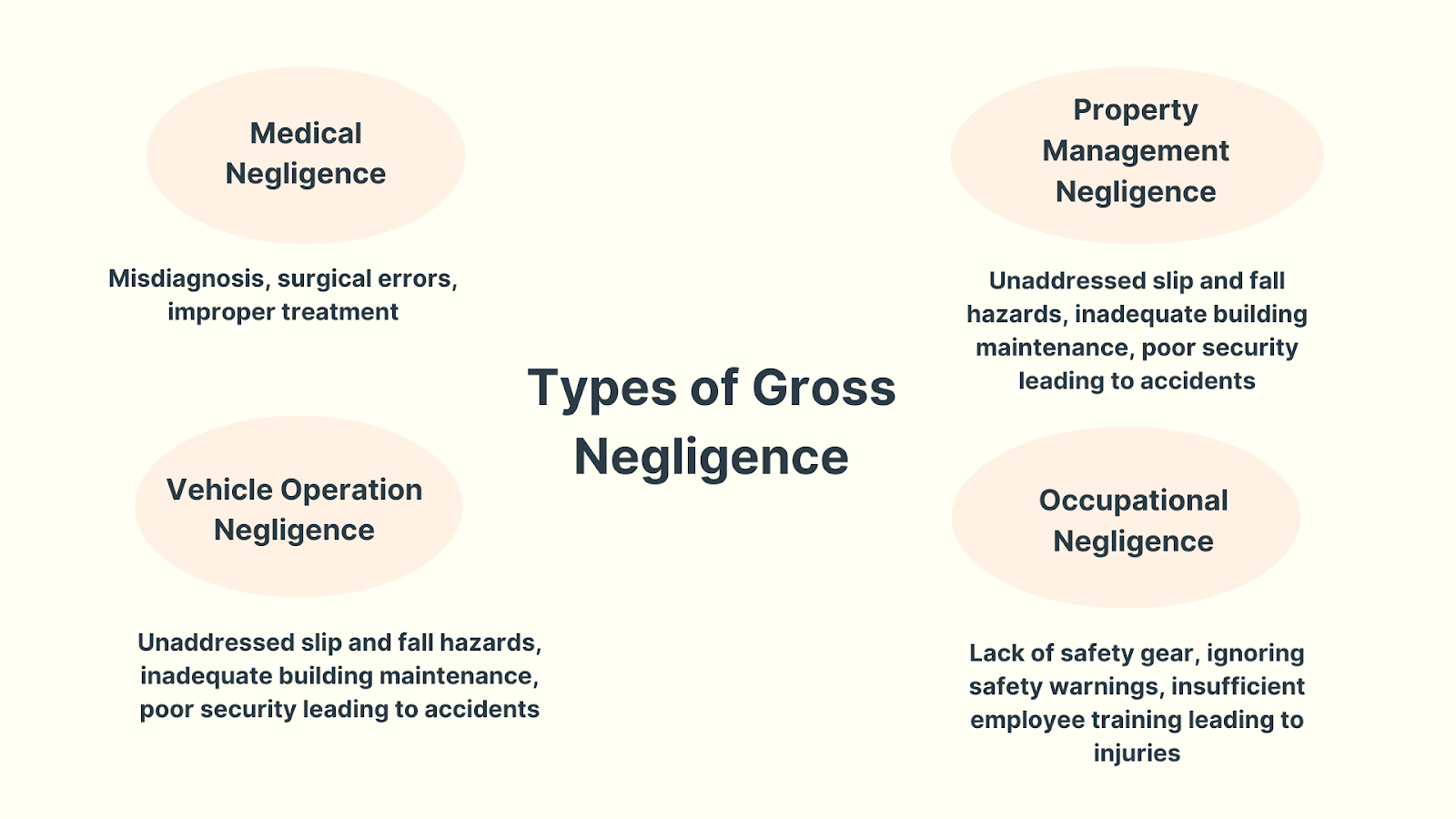In the streets of California, accidents and injuries are a common occurrence. However, not all accidents are the same. Some are considered ‘gross negligence,’ a term that carries significant weight in personal injury cases. Gross negligence is more than just simple carelessness; it represents a serious form of negligence characterized by a blatant disregard for the safety of others.
For anyone involved in a personal injury case in California, understanding the nuances of California gross negligence laws is crucial. It’s important whether you’re a victim seeking justice or someone defending against a claim. Knowing the definition and how gross negligence is established in court can greatly influence the outcome of a case.
Negligence vs. Gross Negligence: The Difference
Negligence refers to a failure to exercise the care that a reasonably prudent person would exhibit under similar circumstances. It’s about carelessness or inattention leading to an accident or injury.
For example, consider a situation where a driver is texting while driving and unintentionally runs a red light, causing an accident. This scenario is typically seen as negligence. The driver’s inattention and failure to adhere to road safety norms, a duty expected of any prudent driver, led to an accident and potential injury.
Gross Negligence, on the other hand, implies a blatant disregard for the safety or lives of others. It’s not just carelessness, but an extreme form of negligence.
For example, a driver speeds recklessly through a busy pedestrian area in California, fully aware of the potential danger but choosing to ignore it. This behavior goes beyond mere carelessness to a deliberate indifference or disregard for the safety and well-being of others.
In California, the legal distinction between negligence and gross negligence is crucial, as it significantly influences the consequences and damages awarded in personal injury cases. Understanding these differences helps clarify the legal responsibilities and potential liabilities faced in various situations.
Understanding the California Gross Negligence Law


California law provides specific guidelines for gross negligence, crucial for plaintiffs and defendants in personal injury cases. One key statute is the California Civil Code Section 1714, which states that everyone is responsible for an injury caused by their lack of ordinary care or skill in the management of their property or person.
However, gross negligence is a more extreme form of negligence, as defined by case law rather than a specific statute. It’s described as the lack of any care or an extreme departure from what a reasonably careful person would do in the same situation to prevent harm to another individual. California courts have interpreted this as not just a failure to use reasonable care, but a reckless disregard for the safety or lives of others.
For example, in the case of City of Santa Barbara v. Superior Court, the California Supreme Court reiterated the definition of gross negligence as a “want of even scant care” or “an extreme departure from the ordinary standard of conduct.”
Here are some types of negligent behaviors:
- Medical Negligence: This involves healthcare professionals failing to provide the standard of care expected, resulting in harm to a patient. This could be through misdiagnosis, surgical errors, or improper treatment.
- Vehicle Operation Negligence: Reckless or impaired driving that leads to accidents and injuries falls under this category.
- Property Management Negligence: This occurs when property owners fail to maintain safe premises, leading to accidents like slips, falls, or other injuries.
- Occupational Negligence: In the workplace, this could include ignoring safety protocols or not providing adequate training, resulting in employee injuries.
Impact of Gross Negligence on Personal Injury Cases
Gross negligence in a personal injury case can significantly impact the outcome, particularly in terms of liability and damages. Understanding the impact of California gross negligence is crucial for both plaintiffs and defendants.
If you or your loved one have been injured due to someone’s gross negligence, it’s time to seek expert legal guidance. The Personal Injury Center connects you with seasoned personal injury lawyers to help you through your journey.
Enhanced Liability
When gross negligence is established, it increases the liability of the defendant. Unlike ordinary negligence, which might result from a momentary lapse in judgment or oversight, gross negligence implies a conscious disregard for the safety of others. This heightened level of culpability can lead to more severe legal consequences for the defendant.
Punitive Damages
One of the most significant impacts of gross negligence is the potential for punitive damages. While compensatory damages are designed to cover the victim’s actual losses (like medical expenses and lost wages), punitive damages are aimed at punishing the defendant for their misconduct. In cases of gross negligence, courts in California are more likely to award punitive damages as a way to discourage similar conduct in the future.
Influence on Settlements and Verdicts
The presence of gross negligence can also influence the negotiation dynamics in a settlement or the decision-making process in a trial.
Knowing that a case involves negligence might prompt a defendant to settle out of court to avoid the risk of punitive damages. Conversely, it could encourage a plaintiff’s position, knowing that the law recognizes the severity of the defendant’s conduct.
Insurance Implications
It’s important to note that many insurance policies do not cover acts of gross negligence. This means that if a defendant is found grossly negligent, they might have to pay punitive damages out of pocket, which can be a significant financial burden.
Proving Gross Negligence in Court


Successfully proving gross negligence in a California court requires a strategic approach and clear, convincing evidence. For plaintiffs, this means demonstrating beyond mere negligence that the defendant acted with a reckless disregard for the safety of others. Here’s how this is typically achieved:
Establishing the Standard of Care
The initial step is to establish the standard of care expected in the given situation, as a reasonably prudent person would observe. This standard varies, but its interpretation has been influenced by cases like Willhide-Michiulis v. Mammoth Mountain Ski Area.
This case highlights the importance of relying on factual evidence rather than legal opinions, especially in situations where risk is a factor. It emphasizes that expert witnesses should focus on facts and avoid giving their own legal conclusions, ensuring that the court receives a clear and factual understanding of the standard of care in each specific case.
Demonstrating a Breach of Duty
Once the standard of care is established, the plaintiff must demonstrate that the defendant breached this duty. In the context of gross negligence, this breach must be significant – not just a minor lapse in judgment or carelessness, but an action or inaction that shows a severe disregard for the safety of others.
In line with the ruling in Anderson v. Fitness Internat., LLC, it’s important to note that even if the defendant presents a release as a defense, they still have the obligation to counter allegations of gross negligence. This means that a simple claim of a release doesn’t automatically dismiss the possibility of gross negligence; the defendant must actively disprove it.
Linking the Breach to the Injury
It’s crucial to directly link the defendant’s grossly negligent behavior to the plaintiff’s injuries. This causal relationship is a key element in any personal injury case. The plaintiff must show that the injury was a foreseeable result of the defendant’s extreme disregard for safety.
Presenting Clear and Convincing Evidence
Proving gross negligence requires a higher standard of proof than ordinary negligence. Plaintiffs must present clear and convincing evidence – a more demanding threshold than the ‘preponderance of the evidence‘ standard used in typical negligence cases. This involves presenting compelling, credible evidence that leaves little doubt about the defendant’s gross negligence.
Utilizing Expert Witnesses
Often, expert testimony is crucial in gross negligence cases. Experts can help establish the standard of care, demonstrate how the defendant’s actions deviated from this standard, and clarify the technical aspects of the case to the court.
Documenting Damages
Finally, documenting the full extent of the damages suffered is essential. This not only includes physical injuries but also emotional distress, loss of income, and other impacts. In gross negligence cases, this also sets the stage for potential punitive damages.
Proving gross negligence in court is a complex process that requires a deep understanding of legal principles and meticulous preparation. The Personal Injury Center can be an invaluable resource in such cases, connecting individuals with experienced lawyers who specialize in navigating these challenging legal waters.
Preventative Measures to Avoid Gross Negligence


Preventing gross negligence is critical for both individuals and businesses, as the legal and financial consequences can be severe. Implementing proactive strategies can significantly reduce the risk of incidents that may lead to gross negligence claims.
Here are key measures to consider:
- Strict Adherence to Safety Protocols: For businesses, especially those in high-risk industries, adhering to established safety protocols is essential. Regular training sessions should be conducted to ensure all employees are aware of these protocols. For example, a construction company must ensure that all workers wear safety gear and follow safety guidelines rigorously.
- Regular Risk Assessments: Conducting regular risk assessments can help identify potential hazards before they lead to accidents. This involves evaluating work processes, environments, and equipment to ensure they meet safety standards. For individuals, this could mean being more aware of their actions and surroundings, such as avoiding distractions while driving.
- Maintaining Equipment and Infrastructure: Regular maintenance of equipment and infrastructure is crucial to prevent accidents. This could range from ensuring vehicles are serviced regularly to keeping public spaces and buildings in safe, working condition.
- Clear Communication and Training: Effective communication about safety practices and risks is vital. This includes providing clear instructions and training to employees about safe work practices and ensuring that individuals understand the importance of adhering to safety rules.
- Legal Compliance: Staying updated with legal requirements and ensuring compliance with all relevant laws and regulations is crucial. This includes understanding the laws specific to your industry or activities and ensuring all operations are legally compliant.
- Documenting Safety Efforts: Keeping a record of safety efforts, training, maintenance, and compliance can be invaluable, especially if faced with a legal claim. Documentation serves as evidence of a proactive approach to preventing negligence.
Explore Legal Solutions With the Personal Injury Center
Navigating the legal intricacies of California gross negligence laws can be overwhelming, but you don’t have to do it alone. The Personal Injury Center is here to guide you through this challenging time.
By reaching out to us, you gain access to a network of specialized attorneys in your area, each with the expertise to handle your unique case. Let The Personal Injury Center be your first step towards securing justice and embarking on your recovery path.
Key Takeaways
|



